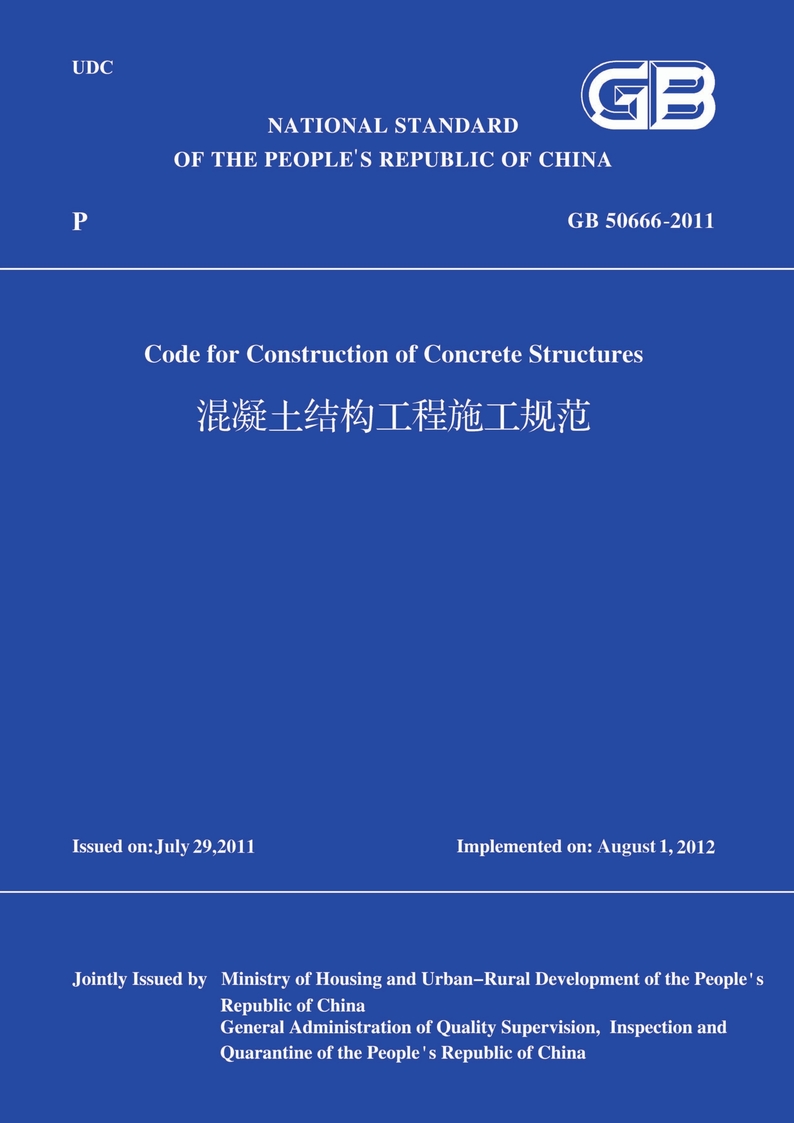发布日期:2011-07-29
实施日期:2012-08-01
主编部门:Ministry of Housing and Urban-Rural Development of the People's Republic of China
主编单位:China Academy of Building Research
主要起草人:Yuan Zhenlong,Cheng Zhijun,Wang Yuling,Wang Cangzhou,Wang Xiaofeng,Wang Zhangfu,Zhu Wanxu,Zhu Guangxiang,Li Xiaoyang,Li Dongbin,Li Hongwei,Li Jingfang,Xiao Xuwen,Wu Yuehua,He Xiaoyang,Leng Faguang,Zhang Yuanbo,Zhang Tongbo,Lin Xiaohui,Zhao Tingsheng,Zhao Yong,Jiang Bo,Geng Shujiang,Guo Zhengxing,Guo Jingqiang,Gong Jian,Jiang Qinjian,Lai Yizheng,Lu Laijun
出版社:中国建筑工业出版社
标准书号:GB 50666-2011
出版时间:2014-10-01
This code is a general standard for the construction of concrete structures,which proposes the basic requirements for the construction management and process control of concrete structures.This code strengthens such requirements as energy conservation,land conservation,water conservation,material conservation and environmental protection at the same time of construction quality control,in order to implement the national technical and economic policies and reflect the sustainable development concept in the building field.New technologies,new processes and new materials are actively used in this code.
This code is applicable to the construction of concrete structures in building engineering,not to the construction of lightweight aggregate concrete and special concrete.
This code was jointly prepared by China Academy of Building Research with the organizations concerned according to the requirements of "Notice on Printing'Development and Revision Plan on Engineering Construction Standards and Codes in 2007 (First Batch)'" (Jian Biao [2007] No.125) issued by the former Ministry of Construction.
This code is a general standard for the construction of concrete structures,which proposes the basic requirements for the construction management and process control of concrete structures.This code strengthens such requirements as energy conservation,land conservation,water conservation,material conservation and environmental protection at the same time of construction quality control,in order to implement the national technical and economic policies and reflect the sustainable development concept in the building field.New technologies,new processes and new materials are actively used in this code.
During the preparation process of this code,practical experiences and research achievements in the concrete structure construction in China in recent years were summarized,the relevant international and foreign advanced standards were used for reference,multiple monographic studies were carried out,the opinions of the parties concerned were widely solicited,the specific contents were discussed,coordinated and modified over and over again,and this code was finalized upon review.
This code comprises 11 chapters and 6 appendixes.Main contents include:general provisions,terms,basic requirements,formwork,reinforcement,prestressed concrete,concrete production and transportation,cast-in-situ concrete,precast concrete,construction in cold,hot and rainy weather,environmental protection.
The provisions printed in bold type in this code are compulsory ones and must be enforced strictly.
The Ministry of Housing and Urban-Rural Development is in charge of the administration of this code and the explanation of the compulsory provisions;the China Academy of Building Research is responsible for the explanation of specific technical contents.All relevant organizations are kindly requested to sum up and accumulate your experiences in actual practices during the process of implementing this code.The relevant opinions and advice,whenever necessary,can be posted or passed on to "Code for Construction of Concrete Structures" Administrative Group of the China Academy of Building Research (Address:No.30,North Third Ring East Road,Chaoyang District,Beijing,100013;E-mail:concode@126.com) for future reference.
Chief Development Organizations:China Academy of Building Research
Participating Development Organizations:China Construction Eighth Engineering Division Shanghai Construction Group Co.,Ltd.China Construction Second Engineering Bureau LTD.China Construction First Building (Group) Corporation Limited China Railway Construction Engineering Group Co.,Ltd.Zhejiang Greatwall Construction Group Co.,Ltd.Qingjian Group Co.,Ltd.Beijing Construction Project Management Association Central Research Institute of Building and Construction of MCC Group Co.,Ltd.Heilongjiang Province Academy of Cold Area Building Research Southeast University Tongji University Huazhong University of Science and Technology Beijing Yugou Co.,Ltd.Shui On Land Limited Peifeng Construction Engineering (Shanghai) Co.,Ltd.Beijing Dongfang Jianyu Concrete Scientific and Technical Research Institute Zhejiang Huawei Building Material Group Co.,Ltd.Sika China Guangzhou Yufeng Group LTD.Liuzhou OVM Machinery Co.,Ltd.
Chief Drafting Staff:Yuan Zhenlong Cheng Zhijun Wang Yuling Wang Cangzhou Wang Xiaofeng Wang Zhangfu Zhu Wanxu Zhu Guangxiang Li Xiaoyang Li Dongbin Li Hongwei Li Jingfang Xiao Xuwen Wu Yuehua He Xiaoyang Leng Faguang Zhang Yuanbo Zhang Tongbo Lin Xiaohui Zhao Tingsheng Zhao Yong Jiang Bo Geng Shujiang Guo Zhengxing Guo Jingqiang Gong Jian Jiang Qinjian Lai Yizheng Lu Laijun
Chief Examiners:Ye Keming Yang Sixin Hu Dejun Zhong Bo Ai Yongxiang Zhao Yuzhang Zhang Liangjie Wang Daojin Zhang Kun Chen Hao Gao Junyue Bai Shengxiang Han Sufang Xu Youlin Li Chenguang You Tianzhi Zheng Wenzhong Feng Jian Wei Jiandong Cong Xiaomi Yang Sizhong
Announcement of the Ministry of Housing and Urban-Rural Development of the People's Republic of China
No.1110
Announcement of Publishing the National Standard of Code for Construction of Concrete Structures
Code for Construction of Concrete Structures has been approved as a national standard with a serial number of GB 50666-2011 and will be implemented from August 1,2012.Therein,Articles (Items) 4.1.2, 5.1.3, 5.2.2, 6.1.3, 6.4.10, 7.2.4 (2), 7.2.10, 7.6.3 (1), 7.6.4 and 8.1.3 are compulsory provisions and must be enforced strictly.
Authorized by Research Institute of Standards&Norms,this code is published and distributed by China Architecture&Building Press.
Ministry of Housing and Urban-Rural Development of the People's Republic of China
July 29,2011
目录
Announcement of the Ministry of Housing and Urban-Rural Development of the People's Republic of China
Foreword
1 General Provisions
2 Terms
3 Basic Requirements
3.1 Construction Management
3.2 Construction Technology
3.3 Construction Quality and Safety
4 Formwork
4.1 General Requirements
4.2 Materials
4.3 Design
4.4 Fabrication and Installation
4.5 Removal and Maintenance
4.6 Quality Control
5 Reinforcement
5.1 General Requirements
5.2 Materials
5.3 Reinforcement Fabrication
5.4 Reinforcement Splice and Fixing
5.5 Quality Control
6 Prestressed Concrete
6.1 General Requirements
6.2 Materials
6.3 Fabrication and Installation
6.4 Tensioning and Releasing of Prestress
6.5 Grouting and Anchorage Protection
6.6 Quality Control
7 Concrete Production and Transportation
7.1 General Requirements
7.2 Materials
7.3 Mix Proportioning
7.4 Mixing
7.5 Transportation
7.6 Quality Control
8 Cast-in-situ Concrete
8.1 General Requirements
8.2 Conveying
8.3 Placing
8.4 Compacting
8.5 Curing
8.6 Construction Joint and Post-cast Strip
8.7 Crack Control of Mass Concrete
8.8 Quality Control
8.9 Repair of Concrete Defects
9 Precast Concrete
9.1 General Requirements
9.2 Checking
9.3 Production
9.4 Storage and Transportation
9.5 Erection
9.6 Quality Control
10 Construction in Cold,Hot and Rainy Weather
10.1 General Requirements
10.2 Cold Weather Requirements
10.3 Hot Weather Requirements
10.4 Rainy Weather Requirements
11 Environmental Protection
11.1 General Requirements
11.2 Environmental Considerations
Appendix A Characteristic Value of Loads Acting on Formwork
Appendix B Nominal Diameter,Nominal Sectional Area,Calculation Sectional Area and Theoretical Weight of Common Reinforcements
Appendix C Minimum Splicing Length of Longitudinal Reinforcements
Appendix D Calculation and Measurement Method for Elongation of Prestressing tendons
Appendix E Testing Method for Loss of Prestress Due to Friction
Appendix F Specification of Concrete Materials
Explanation of Wording in This Code
List of Quoted Standards
4.1.2 Forms and their supports shall be designed to have adequate load-carrying capacity andrigidity and to ensure the overall stability according to various operating conditions during the construction.
5.1.3 When the reinforcement is required to be replaced, the design change documents shall beprepared.
5.2.2 As for structures with requirements for seismic resistance, the properties of longitudinal steelreinforcements shall meet the design requirements; where there are no specific requirements in the design, as for the frames and diagonal brace members (including stairflight) designed according to Aseismatic Grade Ⅰ,Ⅱ and Ⅲ, the longitudinal steel reinforcements shall adopt HRB335E, HRB400E, HRB500E, HRBF335E, HRBF400E or HRBF500E, while the strength and measured value of total elongation at maximum force shall meet the following requirements:
1 The ratio of the measured value of tensile strength to that of yield strength of steel reinforcement shall not be less than 1.25;
2 The ratio of the measured value of yield strength to the characteristic value of yield strength of steel reinforcement shall not be greater than 1.30;
3 The total elongation of steel reinforcement at maximum force shall not be less than 9%.
6.1.3 The replacement of prestressing tendons shall be calculated specially and confirmed by theoriginal design organization.
6.4.10 Fracture or slipping shall be avoided during tensioning operation for prestressing tendons.Fracture or slipping, if occurred, shall meet the following requirements:
1 As for post-tensioned prestressed structural members, quantity of prestressing tendons with fracture or slipping must not exceed 3%of the total prestressing tendons on the same section and shall not exceed one in each bundle of steel wires or each stick of steel strands; as for multi-span two-way continuous slab, fracture or slipping shall be counted on the same section for each span;
2 As for pre-tensioned prestressed members, prestressing tendons fractured or slipped must be replaced before concreting;
7.2.4 Fine aggregate should adopt clean natural sand or manufactured sand with good grading and sufficient soundness and shall meet the following requirements:
1Fine aggregate should adopt medium granular sand in Area Ⅱ.When it adopts sand in Area I,the sand ratio shall be increased and enough cementitious materials shall be used and requirements for concrete workability shall be satisfied;when it adopts sand in Area Ⅲ,the sand ratio shall be decreased appropriately;
2 The chloride ion content in concrete fine aggregate, for reinforced concrete, shall not be larger than 0.06%in the calculation according to the mass fraction of dry sand; for prestressed concrete, it shall not be larger than 0.02%, in the calculation according to the mass fraction of dry sand;
3Clay content and clay lump content shall meet the requirements of Appendix F in this code;
4 Sea sand shall meet the relevant requirements of current professional standard JGJ 206Technical Code for Application of Sea Sand Concrete.
7.2.10 Untreated seawater must not be used for mixing and curing concrete in reinforced concretestructures and prestressed concrete structures.
7.6.3 Site acceptance of materials shall meet the following requirements:
1 Strength, soundness and setting time of cement shall be inspected.For cement of same grade, type, batch number from the same manufacturer, continuously arriving at the site, bagged cements of not more than 200t shall be a lot and bulk cement of not more than 500t shall be a lot.
2Size grading,clay content,clay lump content,content of elongated flaky particle of coarse aggregate shall be inspected and the crush index may be inspected when necessary;size grading,clay content and clay lump content of fine aggregate shall be inspected.Alkali reactivity of aggregates shall be inspected when there are requirements in design document or the structure is in the environment prone to alkaline-aggregate reaction.Soundness inspection shall be applied for aggregates for concrete with freeze-thaw resistance grade F100 and above.Aggregates of not more than 400m3or 600t may be an inspection lot.
3Fineness (specific surface area),water requirement ratio (fluidity ratio),activity index (compressive strength ratio) and ignition loss of mineral admixtures shall be inspected.Fly ashes,slag and zeolite powders of not more than 200t shall be an inspection lot and silica fume of not more than 30t shall be an inspection lot.
4The chief homogeneity indexes of admixtures shall be inspected according to the product standard,and the performance indexes of the concrete added with admixtures shall be inspected.Same admixtures of not more than 50t should be an inspection lot.
5When drinking water is used for concrete mixing,it may not be inspected.For other water like reclaimed water,cleaning water in mixing plants or circulating water in construction site,compositions shall be analyzed.
7.6.4 When the cement in use is subject to unfavorable ambient influences or the cement has beendelivered over three months(a month for rapid hardening Portland cement),re-inspection shall be carried out and the cement shall be used according to the re-inspection results.
8.1.3 Water must not be added to concrete during transportation, conveying and placingprocesses; concrete shattered in transportation, conveying and placing processes must not be used in casting concrete structural members.








